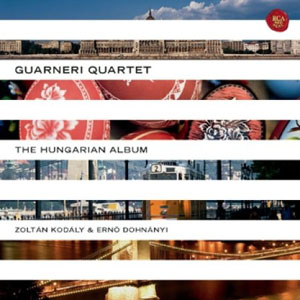 The Guarneri Quartet is one of the most distinguished ensembles of the latter half of the twentieth century. It was founded in 1964, reportedly at the instigation of Alexander Schneider of the legendary Budapest String Quartet, although Arnold Steinhardt’s recollection is somewhat different: according to Steinhardt, he, John Dalley, Michael Tree, and Peter Wiley had been playing together informally since their student days and finally decided to form the group that became the Guarneri. Looking at the Quartet’s discography, one is struck by their focus on music of the twentieth century and of Eastern Europe: Bartók, Dvorák, Janáček, Debussy, Grieg, Smetana are all well-represented in their recordings, so this group of quartets by Dohnányi and Kodály is a good fit — although sadly, it marks the group’s retirement.
The Guarneri Quartet is one of the most distinguished ensembles of the latter half of the twentieth century. It was founded in 1964, reportedly at the instigation of Alexander Schneider of the legendary Budapest String Quartet, although Arnold Steinhardt’s recollection is somewhat different: according to Steinhardt, he, John Dalley, Michael Tree, and Peter Wiley had been playing together informally since their student days and finally decided to form the group that became the Guarneri. Looking at the Quartet’s discography, one is struck by their focus on music of the twentieth century and of Eastern Europe: Bartók, Dvorák, Janáček, Debussy, Grieg, Smetana are all well-represented in their recordings, so this group of quartets by Dohnányi and Kodály is a good fit — although sadly, it marks the group’s retirement.
Ernö Dohnányi (who customarily used the German form of his name, Ernst von Dohnanyi) was a prominent figure in the Hungarian musical community in the early years of the twentieth century. As such, he was aware of the currents of European musical thought and, unlike many of his contemporaries, was much more prone to be influenced by the likes of Schoenberg (at least, the early Schoenberg) and Dvorák (in “high art” mode) than traditional melodies and folk idiom. Indeed, the title of this CD notwithstanding, his Quartet No. 2 has nothing particularly Hungarian about it.
There is a certain element of melancholy in the first movement of Dohnányi’s Quarter No. 2, beginning with the opening phrase for solo violin, which is repeated throughout the movement, although there are passages that attempt, with only moderate success, to break through into a lighter mood. The second movement, marked “presto acciacato,” is labeled by commentator Eric Wen as a “menacing scherzo,” although quite honestly, I don’t hear it. “Scherzo,” yes — menacing? Not so much. (One is reminded at times like this of Ned Rorem’s dictum that music has no intrinsic meaning. I start to see his point.) The overall thrust seems almost pastoral to my ears, except that there is a fair amount of “busyness” implicit in the hurried figures that drive the movement. The third movement returns to solemnity — indeed, it goes beyond melancholy to the borders, at least, of what Wen calls a “dirge,” although it doesn’t really possess that weight. And maybe that’s my problem with this work: when all is said, it’s fairly insubstantial, and I like some meat to my music.
The Quartet No. 3 seems almost like a continuation of .No. 2, and I begin to see the sense of putting the Kodály Quartet No. 2 between them. Without that break, one would be hard put to determine where one ends and the other begins. The Third, however, does mark itself as a twentieth-century work, more adventurous than its predecessor (although composed in the twentieth century — 1906 — it’s still a nineteenth-century composition), and builds a nice tension — the opening movement is fittingly labeled “agitato” as well as “appassionato.” The second movement, “andante religioso con variazioni,” is appropriately reverent and reminds me of nothing so much as the church services I used to sleep through. The third movement, “vivace giocoso,” is lively enough, opening with a nice lilt that serves to regenerate some of the momentum lost in the second movement.
In sharp contrast to the cosmopolitan and au courant Dohnányi, Zoltan Kodály was among the first to undertake the study of folk tales and folk music, becoming one of the more significant early ethnomusicologists. He was, in fact, a mentor to Bela Bartók, whom he taught how to collect folk songs.
Kodály’s Quartet No. 2, Op. 10 was composed in 1916-17 and leaves no doubt from the beginning that it is a twentieth-century work. It also reveals a strong foundation in Hungarian folk music, not so much incorporating the melodies — although a folk-style dance does appear in the second part of the second movement — as assuming the methods and structures. It’s apparent that Kodály and Bartók shared a certain approach in this regard. However you parse it, this is not art music on the Western European model, although it partakes very heavily of the new styles of composition and even reaches back to Brahms, in a way: there are passages of melting lyricism juxtaposed against passages of high tension that recall similar episodes in Brahms’ works — although here in a much smaller scale. The quartet provides a good, strong center to this collection.
Although Dohnányi’s two quartets don’t do much for me, I suspect that’s as much a result of my own taste as the writing — I suspect he’s just too conservative for me. I’m much more comfortable with the Kodály. Needless to say, the performances are flawless, revealing not only the Guarneri’s sympathy and understanding of the music, but also their long career as an ensemble — it’s like they’re reading each other’s minds.
(Sony Music Entertainment, 2009)
